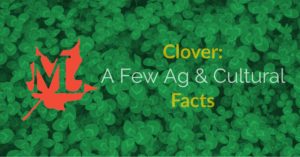While popular culture in the United States has basically reduced St. Patrick’s Day to “wear green, get drunk” the life of the Saint this Catholic Feast Day commemorates is quite fascinating, and his symbol, clover, is actually very useful in modern day organic agricultural.
St. Patrick used the clover as a representation of The Holy Trinity in his teachings of Christianity. St. Patrick is the Patron Saint of Ireland, but he wasn’t born there. At age sixteen St. Patrick was captured and forced into slavery. His unrelenting faith in God pulled him through the trials of living as a slave. After six years, an angel appeared to him in a dream and showed him the way to freedom. St. Patrick was then called by God to travel throughout Ireland spreading the Good News, helping people, and building churches.
Celtic Priests believed that when they carried a 3-leaf clover, or shamrock, that they could see evil spirits coming and have time to get away.
The Irish believe the four-leaf clover represents faith, hope, love, and of course, luck. The luck of the Irish, of course.
The commonly accepted probability of finding a 4-leaf clover today is 1 in 10,000.
The Irish claimed to have the most 4 leaf clovers for centuries, and probably did. But with the rise of organic agricultural practices in recent decades, they may have competition elsewhere on the map.
Clover is great for Bee populations and attracts other beneficial bugs.
The flowering clover also attracts butterflies and insects that prey upon garden pests, such as mites and aphids. It also attracts earthworms, which are great for soil and crops as well.
Planting clover is an organic fertilization method.
Using bacteria in its root systems, clover has the ability to organically convert nitrogen into fertilizer. If done properly, it can completely eliminate the need to supplement with chemical nitrogen fertilizer, which has a higher risk of seeping into the ground water among other dangers. This works for large scale agriculture and backyard gardens just the same.
Clover also reduces soil erosion and the spread of mites.
Planted between the rows of fruit trees, hops, or other crops grown naturally or organically clover keeps the dust down during mowing. Kicking up dust can transfer mites from the soil to the fruit or leaves and damage crops. Clover has deep tap roots and spreads quickly, which prevents top soil loss and erosion due to furrow irrigation and wind.
You could even have a clover lawn if you really want one.
Once planted in weed-free soil, clover spreads rapidly and will crowd out broadleaf weeds. It makes a beautiful emerald green lawn alone, or as a mixture with grass. It’s eco-friendly and low-maintenance too. And hey, you’ll probably find a 4-leaf clover or two!
Maple Leaf Landscaping & maintenance wishes you a safe and Happy St. Patrick’s Day 2018.
For more information you can visit
https://modernfarmer.com/2015/03/clover-comeback/
https://www.almanac.com/content/clover-comeback
https://www.bhg.com/holidays/st-patricks-day/traditions/fun-facts-about-four-leaf-clovers/

